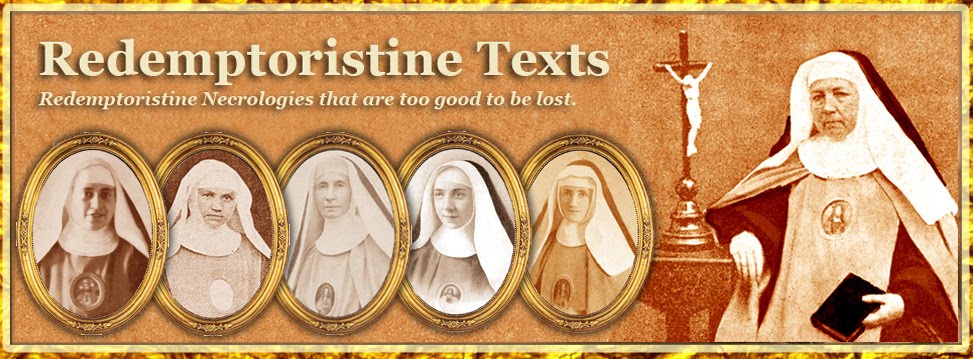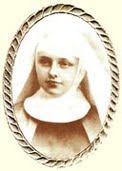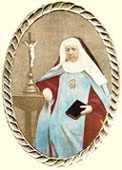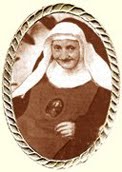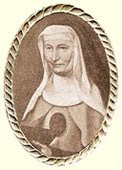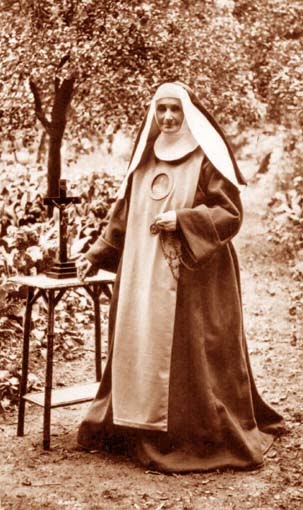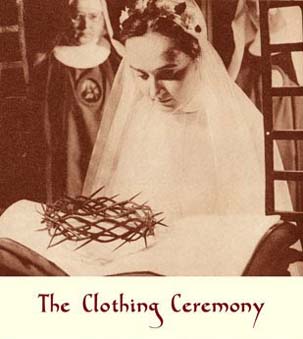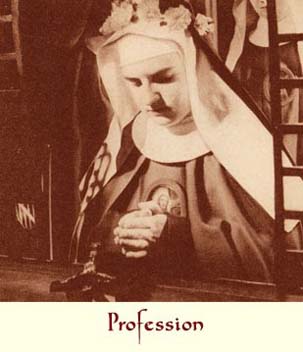Chapter III. The virtues of the venerated Mother.
I. Her love for the Rule. – Her Faith, her Hope and her Love for God.
If her care for their temporal administration made the wisdom of Mother Marie-Joseph stand out, then her daughters admired her even more for the zeal and the gentle sweetness with which she strove to inculcate the spirit of Saint Alphonsus in them.
Let us say first of all that her government was mild and sweet, and full of openness and uprightness. The sensitivity of her procedures was exquisite, her conversation simple and very dignified, her nature was bright and open, and at the same time, sensible and generous.
The great preoccupation of the Mother Foundress was to inculcate in her daughters a love of regularity. She herself was the faithful observer of it, and if we can call perfect the religious who observes her vows and Rules exactly, then we can count Mother Marie-Joseph among the number of these chosen souls, who are the pearls of the convents they inhabit. Sometimes she would say to her daughters: “If you do not observe the Rule, I myself shall be your accuser at God’s tribunal”, and also: “A good religious must be a living Rule by her fidelity in observing it in the smallest details and as perfectly as possible, always having before her eyes her divine Model, Our Lord Jesus Christ.”
Her faith was a living one. She had an extraordinary esteem for all the maxims of our holy religion, and the most entire submission to the teachings of the Church, of which she loved to proclaim herself as its daughter. One day a person praised a controversial article to her, and encouraged her to read it. “I shall prefer not to”, she replied, “It is enough for me to believe.” She greatly recommended the spirit of faith, and supernatural views: “See Our Lord in all your Sisters,” she would say, “and serve Him in their persons. Seek to give them pleasure, in order to please Jesus Christ Himself.” “Always see everything in God,” she would also say, “and go straight to God in everything.” And at other times: “In all your actions, make sure you address them: Straight to God! And then they will go straight to heaven.” If someone appeared to be cast down: “Sursum corda!” she would tell them, “What is it in the face of eternity!”
To strengthen the spirit of faith more and more in the hearts of her daughters, she employed all the means indicated by the Rule: retreats, instructions, chapters, special talks and everything which could feed piety and stimulate fervour.
Her firm hope and confidence in God sustained her in all her difficulties, and in the midst of her most grave concerns she would say: “Oh, I put all of that into the heart of our good God.” She had a special gift of bringing peace to troubled souls. To one of them she said: “The good God is all love and mercy, and on our part especially, He wishes to be glorified by our confidence and love. Let us always be guided by the thoughts of our faith, and let us count on Our Lord alone. Let us tell Him often: ‘I despair of myself, but I hope for everything in You.’”
She had a very great confidence in the divine Providence, and received unexpected help many times. At the end of one year, when she had nothing to pay the suppliers of the community with, she was suddenly called to the parlour. There she found Reverend Father Darras, given the task by a charitable person of doing a good work in her name. The good Father had the inspiration to bring the sum of three thousand francs to the community, which he was permitted to dispose of. It is unnecessary to say that it was received with the greatest gratitude. It was just equal to the present needs of the community.
Mother Marie-Joseph made the love of God the continual object of her prayers and thoughts. She loved prayer and the contemplative life, she consecrated to it all the moments she could find, and when the days had been overloaded with occupations, she would employ a part of the night for it. In the last times of her life, her long insomnia permitted her to pray a great deal, and rosaries, ejaculatory prayers, meditations and conversations with God succeeded each other with no relaxation. Her devotion to the Blessed Sacrament, and the long visits she made to Our Lord, proved her love and maintained this divine fire in her. “I shall nourish”, we read in this respect in her resolutions for her retreat, “I shall nourish in myself a great devotion to the Blessed Sacrament. May Holy Communion be all my delight and may I always prepare myself for it with more care and love. I shall do a novena on the first Fridays so as to grow in love. May my whole life be a continual preparation for prayer by a complete abnegation of myself. I shall watch attentively to guard my heart so that Jesus alone may reign there, and if creatures wish to enter, I shall give my heart to God, begging Him to forever be its unique possessor.
“I shall recite the Divine Office with great attention and interior recollection. I shall not voluntarily lose a single moment, praying always, be it in coming and going, or in working. I shall often keep company with Jesus in His Passion. When meditating on the love of Jesus, my soul shall learn to find her happiness, her joy, her peace and her treasure in Him. The Passion of Our Lord shall be engraved more profoundly each day upon my soul. The more I shall consider it, the more I shall love this good Saviour. As much as possible, I shall try to be exact in doing the Way of the Cross.”
This was not just a matter of sentiments. Mother Marie-Joseph realised them in practice. She admitted to one of her daughters that, during the first six months of her stay at Kain, she had always lived in union with the Blessed Sacrament, practising the spirit of adoration almost as if she had always been in the chapel. “There are graces,” she added, “that I must not lose by my own fault.”
The divine charity that inflamed the heart of the good Mother had necessarily to be translated by an ardent zeal for the glory of God and the salvation of souls. As a worthy daughter of Saint Alphonsus, her whole life was inspired by this sacred fire. Her works, the Monastery she had founded, the souls formed by her to perfection, the instructions that she had given them, all were the fruit of the divine love that was consuming her soul. Unceasingly she recommended to her daughters to pray for sinners, for the holy Church, the Sovereign Pontiff, the priests and especially the missionaries. The sins of mankind excited her zeal and led her to preach the great duty of reparation. To this effect she established the Association of the Guard of Honour in the Monastery chapel. On every first Friday of the month there was Exposition of the Blessed Sacrament during the day with prayers of reparation recited publicly at Benediction. Each year there was a day of Adoration in union with the Basilica of Montmartre, and each week a day specially set aside for prayers of reparation.
And often too she told her daughters: “Remember that you are Redemptoristines, and that this title obliges you to work for the salvation of souls in union with Jesus the Redeemer.”
How could so fervent a spouse of the Lord not be penetrated by the most tender devotion towards the Blessed Virgin? Every day, she recited the Rosary in its entirety, and prepared herself for all the feasts of the Queen of the Angels by novenas, and sometimes even by forty days of prayers. Often, on the day of the feast of her good Mother of Heaven, she would offer her a crown of a thousand Ave Maria's. To do this she used part of the night, as she did not have enough free time to do so during the day. She encouraged her daughters to a great love for the Blessed Virgin. On the vigil of her feasts, she would deliver to the community, gathered together in the evening, some words of edification concerning the feast for the next day, in order to get them to celebrate it piously.
She requested and obtained an affiliation to the Archconfraternity of Our Lady of Perpetual Help being established in the Monastery chapel, under the direction of the Chaplain, who assembled the members of the Association each month and gave them a homily. The feast of Our Lady of Perpetual Succour was solemnised in a very special manner. She established the custom of having a procession in the Monastery on that day, with the chanting of canticles and the recitation of prayers. At the end of the procession, a solemn consecration was made before the picture of the Madonna, by which the Blessed Virgin was established as the Mother and Superior of the community.
The revered Mother also had a great devotion to Saint Joseph, her holy Patron, the head of the Holy Family, under whose patronage she had placed the Monastery of Saint-Amand. She had recourse to him in all her temporal needs, and more than once unexpected help came to justify her confidence. She also invoked him as the Patron of the interior life. We read this passage in her Resolutions: “I shall continue my four exercises each day in honour of Saint Joseph, the good saint who has already obtained many graces for me. I shall do them especially with an interior spirit.” Moreover, in the first years of her religious life, she had received an assurance from a very enlightened lady that she would receive great favours by means of her holy Patron.
As a true Redemptoristine, Mother Marie-Joseph honoured Saint Alphonsus as her Father and did not cease to ask from him, for herself and her daughters, love for the vocation to which he had called them. She wanted everyone to be attached to reading the spiritual books of the holy Doctor, especially his magnificent work: The True Spouse of Jesus Christ, an inexhaustible treasury of doctrine which is as consoling at it is sure, and a masterpiece of piety, wisdom and profound learning.
She herself composed some forty prayers of preparation for the feast of Saint Alphonsus, and for it, she proposed a point of the Rule for her daughters to meditate on and put into practice, every day. The Very Rev. Father Desurmont, such a good judge in these matters, looked over this writing and gave it his full approval. As for the feast of the holy Founder, it was solemnly celebrated every year. The chapel was clad in its best ornaments, and as long as the Redemptoristines were at Saint-Amand, the choir of the College of Our Lady of the Angels would sing the Mass in music.
Another devotion was also very dear to Mother Marie-Joseph, that of the holy Angels. She had a very great confidence in their protection against dangers and accidents. During the building of the Monastery, every day, one after another, a Sister had the task of reciting a chaplet of the Sanctus in their honour. She herself recited it daily, and she often said that every time some numerous occupations prevented her from reciting it, her whole day felt the effect of it. She established the custom of saying the Trisagion every evening in common, and they attributed their protection by the Angels to it, and never having had to lament unpleasant accidents in the sometimes dangerous work necessitated by the building of the convent. It was also to honour the holy Angels that the good Mother fixed 2nd October for taking possession of the new Monastery. It was with the same intention that she had seven lamps placed in the sanctuary in honour of the seven Angels who are unceasingly before the throne of God. For this reason we read in her Resolutions: “I shall pray to these blessed Angels to help me to acquire the despoliation and interior detachment that God wishes to find in my soul in order to fill it with His holy love.”
Let us not forget to say that the good Mother Marie-Joseph had a tender devotion for Saint Amand, the Patron of the town where she had established her Monastery. This devotion inspired in her the idea of renewing a tradition interrupted by the French Revolution, and she had a beautiful candle burning in the convent chapel night and day in honour of the great saint. This custom goes back to the 9th century, and it was established following a marvellous event told the way it happened by Father Maës in his very interesting Popular Life of Saint Amand. [2]
“One evening, after the Office, when the monks had left the church and gone back to their cells, the Brother porter, at the moment of closing the doors, noticed two candles alight near the casket enclosing the relics of the holy bishop. Persuaded that he had extinguished all the candles on the altar, he was astonished, but, believing he was wrong, he retraced his steps and extinguished the two candles. Arriving at the extremity of the church, how great was his surprise to see the candles once again alight!
“He returned to the tomb and again extinguished them carefully. Finally, after assuring himself that there was no one in the church, he observed attentively, and then for a third time the candles lit themselves spontaneously. The poor Brother, now distraught, then called all the religious, and told them of what had just happened, and made them witness the miracle.
“It was in memory of this fact that at the beginning of this era, in the abbey, they let a candle burn day and night at the tomb of Saint Amand, and this custom was perpetuated until the Revolution.” [3]
If her care for their temporal administration made the wisdom of Mother Marie-Joseph stand out, then her daughters admired her even more for the zeal and the gentle sweetness with which she strove to inculcate the spirit of Saint Alphonsus in them.
Let us say first of all that her government was mild and sweet, and full of openness and uprightness. The sensitivity of her procedures was exquisite, her conversation simple and very dignified, her nature was bright and open, and at the same time, sensible and generous.
The great preoccupation of the Mother Foundress was to inculcate in her daughters a love of regularity. She herself was the faithful observer of it, and if we can call perfect the religious who observes her vows and Rules exactly, then we can count Mother Marie-Joseph among the number of these chosen souls, who are the pearls of the convents they inhabit. Sometimes she would say to her daughters: “If you do not observe the Rule, I myself shall be your accuser at God’s tribunal”, and also: “A good religious must be a living Rule by her fidelity in observing it in the smallest details and as perfectly as possible, always having before her eyes her divine Model, Our Lord Jesus Christ.”
Her faith was a living one. She had an extraordinary esteem for all the maxims of our holy religion, and the most entire submission to the teachings of the Church, of which she loved to proclaim herself as its daughter. One day a person praised a controversial article to her, and encouraged her to read it. “I shall prefer not to”, she replied, “It is enough for me to believe.” She greatly recommended the spirit of faith, and supernatural views: “See Our Lord in all your Sisters,” she would say, “and serve Him in their persons. Seek to give them pleasure, in order to please Jesus Christ Himself.” “Always see everything in God,” she would also say, “and go straight to God in everything.” And at other times: “In all your actions, make sure you address them: Straight to God! And then they will go straight to heaven.” If someone appeared to be cast down: “Sursum corda!” she would tell them, “What is it in the face of eternity!”
To strengthen the spirit of faith more and more in the hearts of her daughters, she employed all the means indicated by the Rule: retreats, instructions, chapters, special talks and everything which could feed piety and stimulate fervour.
Her firm hope and confidence in God sustained her in all her difficulties, and in the midst of her most grave concerns she would say: “Oh, I put all of that into the heart of our good God.” She had a special gift of bringing peace to troubled souls. To one of them she said: “The good God is all love and mercy, and on our part especially, He wishes to be glorified by our confidence and love. Let us always be guided by the thoughts of our faith, and let us count on Our Lord alone. Let us tell Him often: ‘I despair of myself, but I hope for everything in You.’”
She had a very great confidence in the divine Providence, and received unexpected help many times. At the end of one year, when she had nothing to pay the suppliers of the community with, she was suddenly called to the parlour. There she found Reverend Father Darras, given the task by a charitable person of doing a good work in her name. The good Father had the inspiration to bring the sum of three thousand francs to the community, which he was permitted to dispose of. It is unnecessary to say that it was received with the greatest gratitude. It was just equal to the present needs of the community.
Mother Marie-Joseph made the love of God the continual object of her prayers and thoughts. She loved prayer and the contemplative life, she consecrated to it all the moments she could find, and when the days had been overloaded with occupations, she would employ a part of the night for it. In the last times of her life, her long insomnia permitted her to pray a great deal, and rosaries, ejaculatory prayers, meditations and conversations with God succeeded each other with no relaxation. Her devotion to the Blessed Sacrament, and the long visits she made to Our Lord, proved her love and maintained this divine fire in her. “I shall nourish”, we read in this respect in her resolutions for her retreat, “I shall nourish in myself a great devotion to the Blessed Sacrament. May Holy Communion be all my delight and may I always prepare myself for it with more care and love. I shall do a novena on the first Fridays so as to grow in love. May my whole life be a continual preparation for prayer by a complete abnegation of myself. I shall watch attentively to guard my heart so that Jesus alone may reign there, and if creatures wish to enter, I shall give my heart to God, begging Him to forever be its unique possessor.
“I shall recite the Divine Office with great attention and interior recollection. I shall not voluntarily lose a single moment, praying always, be it in coming and going, or in working. I shall often keep company with Jesus in His Passion. When meditating on the love of Jesus, my soul shall learn to find her happiness, her joy, her peace and her treasure in Him. The Passion of Our Lord shall be engraved more profoundly each day upon my soul. The more I shall consider it, the more I shall love this good Saviour. As much as possible, I shall try to be exact in doing the Way of the Cross.”
This was not just a matter of sentiments. Mother Marie-Joseph realised them in practice. She admitted to one of her daughters that, during the first six months of her stay at Kain, she had always lived in union with the Blessed Sacrament, practising the spirit of adoration almost as if she had always been in the chapel. “There are graces,” she added, “that I must not lose by my own fault.”
The divine charity that inflamed the heart of the good Mother had necessarily to be translated by an ardent zeal for the glory of God and the salvation of souls. As a worthy daughter of Saint Alphonsus, her whole life was inspired by this sacred fire. Her works, the Monastery she had founded, the souls formed by her to perfection, the instructions that she had given them, all were the fruit of the divine love that was consuming her soul. Unceasingly she recommended to her daughters to pray for sinners, for the holy Church, the Sovereign Pontiff, the priests and especially the missionaries. The sins of mankind excited her zeal and led her to preach the great duty of reparation. To this effect she established the Association of the Guard of Honour in the Monastery chapel. On every first Friday of the month there was Exposition of the Blessed Sacrament during the day with prayers of reparation recited publicly at Benediction. Each year there was a day of Adoration in union with the Basilica of Montmartre, and each week a day specially set aside for prayers of reparation.
And often too she told her daughters: “Remember that you are Redemptoristines, and that this title obliges you to work for the salvation of souls in union with Jesus the Redeemer.”
How could so fervent a spouse of the Lord not be penetrated by the most tender devotion towards the Blessed Virgin? Every day, she recited the Rosary in its entirety, and prepared herself for all the feasts of the Queen of the Angels by novenas, and sometimes even by forty days of prayers. Often, on the day of the feast of her good Mother of Heaven, she would offer her a crown of a thousand Ave Maria's. To do this she used part of the night, as she did not have enough free time to do so during the day. She encouraged her daughters to a great love for the Blessed Virgin. On the vigil of her feasts, she would deliver to the community, gathered together in the evening, some words of edification concerning the feast for the next day, in order to get them to celebrate it piously.
She requested and obtained an affiliation to the Archconfraternity of Our Lady of Perpetual Help being established in the Monastery chapel, under the direction of the Chaplain, who assembled the members of the Association each month and gave them a homily. The feast of Our Lady of Perpetual Succour was solemnised in a very special manner. She established the custom of having a procession in the Monastery on that day, with the chanting of canticles and the recitation of prayers. At the end of the procession, a solemn consecration was made before the picture of the Madonna, by which the Blessed Virgin was established as the Mother and Superior of the community.
The revered Mother also had a great devotion to Saint Joseph, her holy Patron, the head of the Holy Family, under whose patronage she had placed the Monastery of Saint-Amand. She had recourse to him in all her temporal needs, and more than once unexpected help came to justify her confidence. She also invoked him as the Patron of the interior life. We read this passage in her Resolutions: “I shall continue my four exercises each day in honour of Saint Joseph, the good saint who has already obtained many graces for me. I shall do them especially with an interior spirit.” Moreover, in the first years of her religious life, she had received an assurance from a very enlightened lady that she would receive great favours by means of her holy Patron.
As a true Redemptoristine, Mother Marie-Joseph honoured Saint Alphonsus as her Father and did not cease to ask from him, for herself and her daughters, love for the vocation to which he had called them. She wanted everyone to be attached to reading the spiritual books of the holy Doctor, especially his magnificent work: The True Spouse of Jesus Christ, an inexhaustible treasury of doctrine which is as consoling at it is sure, and a masterpiece of piety, wisdom and profound learning.
She herself composed some forty prayers of preparation for the feast of Saint Alphonsus, and for it, she proposed a point of the Rule for her daughters to meditate on and put into practice, every day. The Very Rev. Father Desurmont, such a good judge in these matters, looked over this writing and gave it his full approval. As for the feast of the holy Founder, it was solemnly celebrated every year. The chapel was clad in its best ornaments, and as long as the Redemptoristines were at Saint-Amand, the choir of the College of Our Lady of the Angels would sing the Mass in music.
Another devotion was also very dear to Mother Marie-Joseph, that of the holy Angels. She had a very great confidence in their protection against dangers and accidents. During the building of the Monastery, every day, one after another, a Sister had the task of reciting a chaplet of the Sanctus in their honour. She herself recited it daily, and she often said that every time some numerous occupations prevented her from reciting it, her whole day felt the effect of it. She established the custom of saying the Trisagion every evening in common, and they attributed their protection by the Angels to it, and never having had to lament unpleasant accidents in the sometimes dangerous work necessitated by the building of the convent. It was also to honour the holy Angels that the good Mother fixed 2nd October for taking possession of the new Monastery. It was with the same intention that she had seven lamps placed in the sanctuary in honour of the seven Angels who are unceasingly before the throne of God. For this reason we read in her Resolutions: “I shall pray to these blessed Angels to help me to acquire the despoliation and interior detachment that God wishes to find in my soul in order to fill it with His holy love.”
Let us not forget to say that the good Mother Marie-Joseph had a tender devotion for Saint Amand, the Patron of the town where she had established her Monastery. This devotion inspired in her the idea of renewing a tradition interrupted by the French Revolution, and she had a beautiful candle burning in the convent chapel night and day in honour of the great saint. This custom goes back to the 9th century, and it was established following a marvellous event told the way it happened by Father Maës in his very interesting Popular Life of Saint Amand. [2]
“One evening, after the Office, when the monks had left the church and gone back to their cells, the Brother porter, at the moment of closing the doors, noticed two candles alight near the casket enclosing the relics of the holy bishop. Persuaded that he had extinguished all the candles on the altar, he was astonished, but, believing he was wrong, he retraced his steps and extinguished the two candles. Arriving at the extremity of the church, how great was his surprise to see the candles once again alight!
“He returned to the tomb and again extinguished them carefully. Finally, after assuring himself that there was no one in the church, he observed attentively, and then for a third time the candles lit themselves spontaneously. The poor Brother, now distraught, then called all the religious, and told them of what had just happened, and made them witness the miracle.
“It was in memory of this fact that at the beginning of this era, in the abbey, they let a candle burn day and night at the tomb of Saint Amand, and this custom was perpetuated until the Revolution.” [3]
Footnotes
[2] 1 vol in 18-mo of 240 pages. (Desclée, de Brouwer and Co., Lille – Paris, 1894).
[3] This fact is told by the famous monk Milon, after the account of the Abbot Hilderic, an eye-witness.
[3] This fact is told by the famous monk Milon, after the account of the Abbot Hilderic, an eye-witness.
This necrology is translated from Fleurs de l'Institut des Rédemptoristines by Mr John R. Bradbury. The copyright of this translation is the property of the Redemptoristine Nuns of Maitland, Australia. The integral version of the translated book will be posted here as the necrologies appear.
